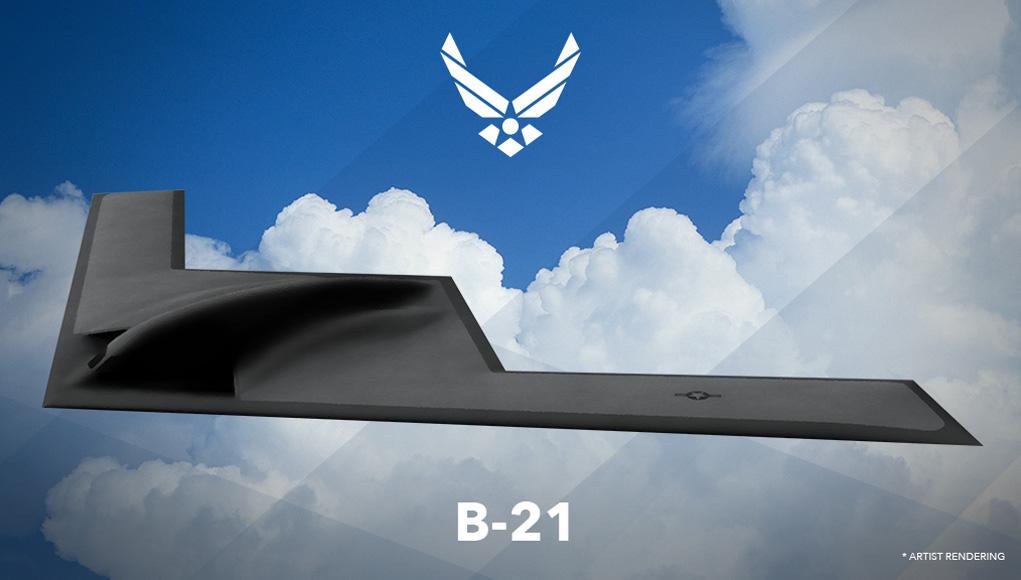After years of intense speculation, the Air Force finally revealed a first image of its long-awaited new bomber, formerly known as the Long Range Strike Bomber (LRS-B) and gave it an official designation – B-21. “Designation B-21 recognizes the LRS-B as the first bomber of the 21st century,” the Air Force said. The program recently entered the Engineering and Manufacturing Development phase and the Air Force plans to field the initial capability of the aircraft in mid-2020s.
“The B-21 will allow the Air Force to operate in tomorrow’s high end threat environment” Air Force Secretary Deborah Lee James said, “Our fifth-generation global precision attack platform will give our country a networked sensor-shoot capability that will allow us to hold targets at risk in a way the world and our adversaries have never, ever seen” Air Force Secretary Deborah Lee James said at her “state of the air force” address at the Air Force Association’s Air Warfare Symposium in Orlando, yesterday.
The new bomber is designed and will be built by Northrop Grumman that also made its predecessor – B-2 Spirit. In fact, the new bomber looks very similar to the B-2. While the B-21 is expected to improve over its predecessor, the B-2 itself was quite an advanced stealth bomber. Its main problem was that of the acquisition of 132 aircraft planned, only 21 were actually built, as it entered service right as the Cold War ended and, after producing only 21 aircraft the production ceased.
16 years later, the Russian threat is back and the need for a new bomber seems acute. In October 2015 the Air Force announced the award of the LRS-B contract to Northrop Grumman. A protest by Lockheed and Boeing slowed the process briefly, but following the removal of this obstacle last week, Northrop Grumman was cleared to proceed. The Air Force plans to purchase a minimum 100 B-21 at a cost of $564 million each. The initial value of the contract is $23.5 billion, but the deal could eventually be $55 or up to $80 billion, of which development costs alone could amount to $23 billion.
“We’ve got to be forward thinking enough to balance winning today’s fight while preparing for tomorrow’s,” said James. “Though the horizon may seem distant, it’s actually just around the corner, and we’re getting ready for takeoff.” Deborah Lee James said.
Indeed, by the mid 2020 B-21 will not be the only new strategic bomber in service. In fact, the development of its Russian stealthy rival – PAK-DA is expected to enter operational service by the mid of the next decade, about the same time for the scheduled initial operational capability of the B-21. Both bombers will be subsonic, and have a flying wing shape, proved most suitable for low observability (stealth). The Russian PAK-DA is developed by the Tupolev Design Bureau, that developed all previous Russian bombers operational today – Tu-160, Tu-95 and Tu-22M3.
B-21 Rival: PAK-DA On the Horizon
The Russians and Americans also share a common view of future growth – speculations said the B-21 could be unmanned at some point of its life; the Russians also plan to introduce unmanned capabilities with their new bombers in the 2040s. Future use of autonomous capabilities may be more subtle than flying an unmanned bomber. “Autonomous platforms could conduct initial [intelligence, surveillance and reconnaissance missions] to identify surface-to-air threats, and relay the information back to the manned package for follow-on electronic warfare operations,” James said. Both Russian and US bombers are expected to fly at high subsonic speeds powered by four turbofan engines. The weight class and range of the B-21 were not released, the Russian bomber will weigh about 120 tons. The requirement is to have an unrefueled range of 6,740 nautical miles. The PAK-DA will be able to carry a payload weight of 60,000 pounds, and will be able to launch new, hypersonic cruise missiles currently in early research and development. The B-21 is also expected to carry a similar weapon. According to Russian Air Force Commander Col. Gen. Viktor Bondarev the prototype will be ready for flight by late 2021, three years later than its original plan for 2019. Accordingly, the completion of the flight testing program could extend to the second half of the 2020s.
The US air force’s current bomber force of B-1Bs, B-52s and B-2s average 34 years of age and the new B-21 is expected to replace all but the Northrop B-2A through the mid-2030s. It will supplement the tiny B-2 fleet and, hopefully, allow the air force to retire is ancient fleet of B-52s that made its first flight in 1952 and seems to be the first aircraft to operate for more than 100 years. The Air Forces’ goal is to operate 175 – 200 bombers, of which at least 100 will be B-21 and the 21 B-2s.
The formal endorsement of the B-21 program comes just weeks after James and Air Force Chief of Staff Gen. Mark A. Welsh III delivered the fiscal year 2017 posture statement before the Senate Appropriations Committee, making it clear modernization is a top priority for the Air Force. “The platforms and systems that made us great over the last 50 years will not make us great over the next 50,” Welsh said during his testimony on Capitol Hill Feb. 10. “There are many other systems we need to either upgrade or recapitalize to ensure viability against current and emerging threats… the only way to do that is to divest old capability to build the new.”























